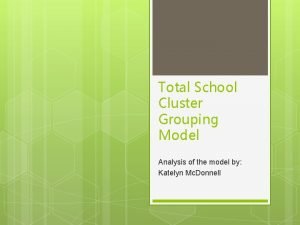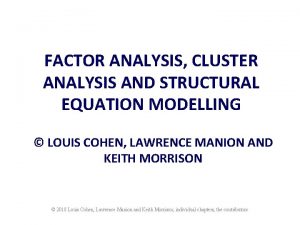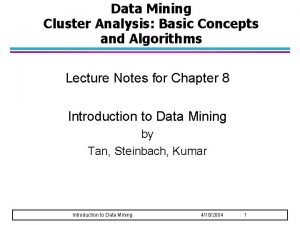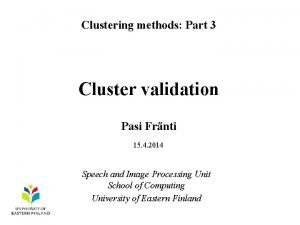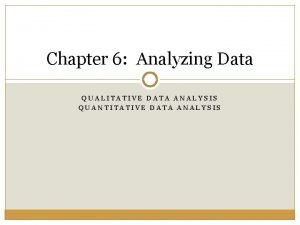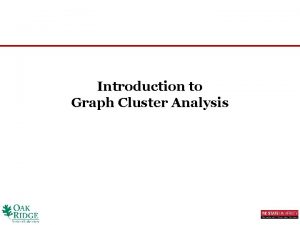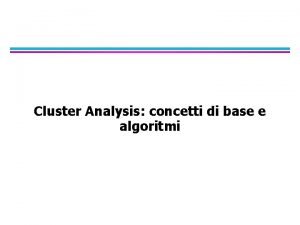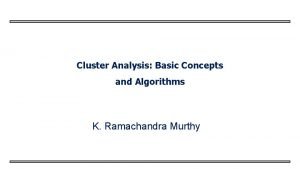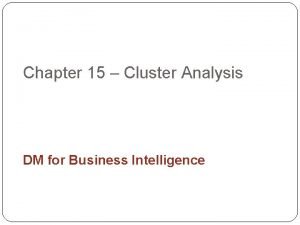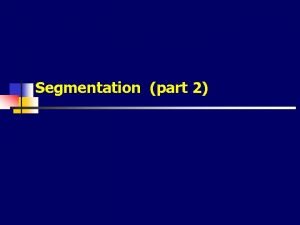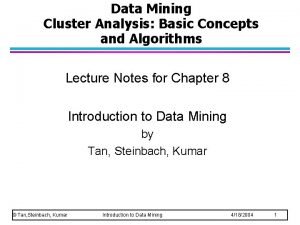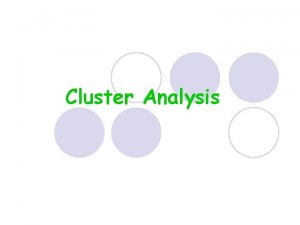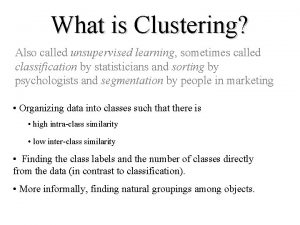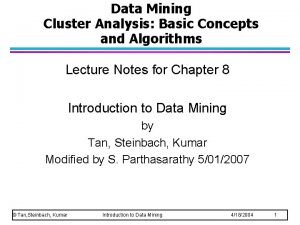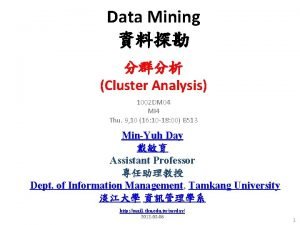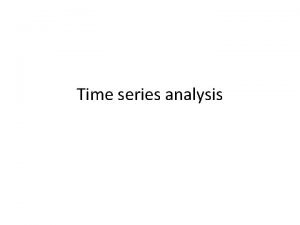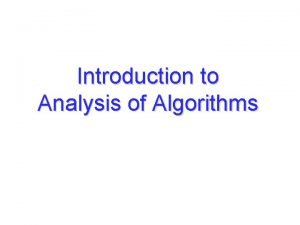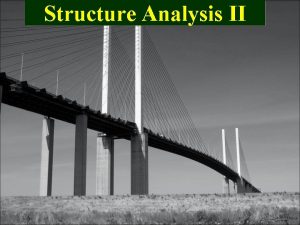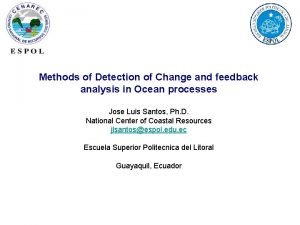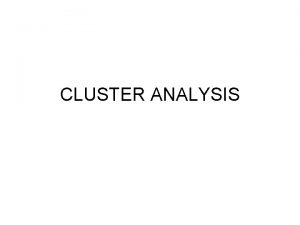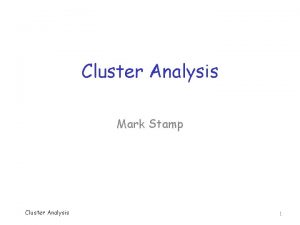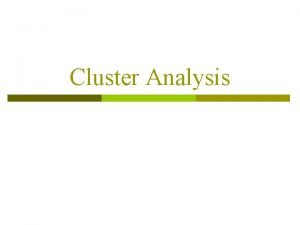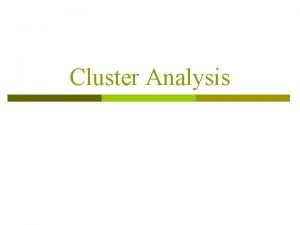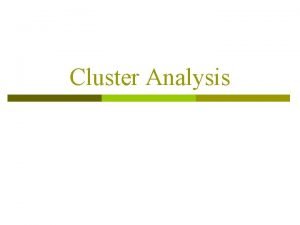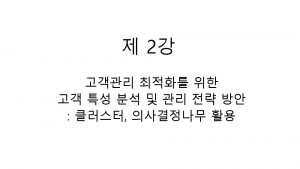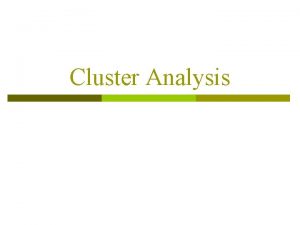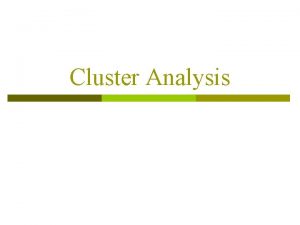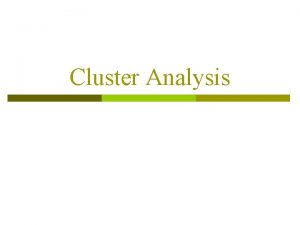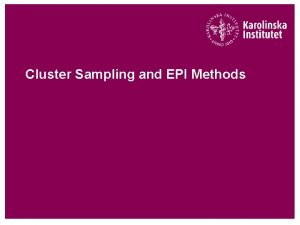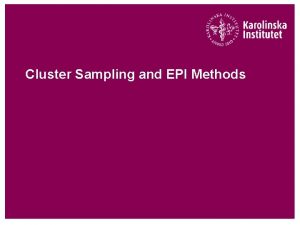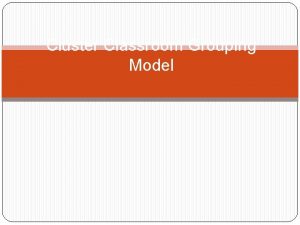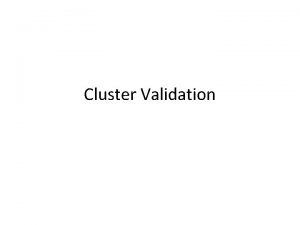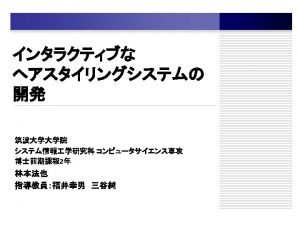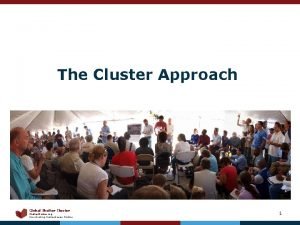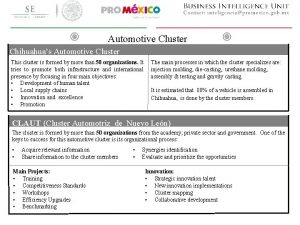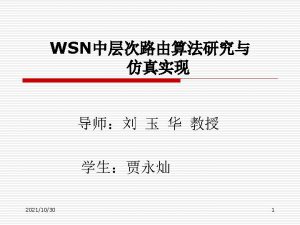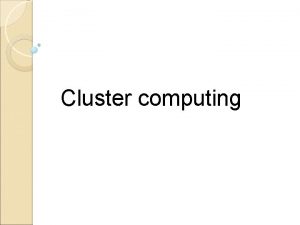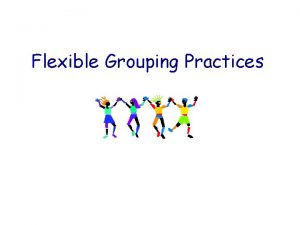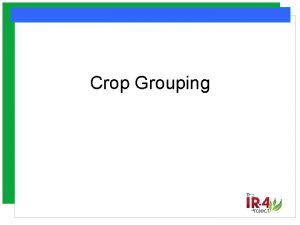Grouping Data Methods of cluster analysis Goals 1



















![# Compare data to randomized sets KMPlot. WSS(Darl. Points[, 6: 9], 1, 10) Qtiles # Compare data to randomized sets KMPlot. WSS(Darl. Points[, 6: 9], 1, 10) Qtiles](https://slidetodoc.com/presentation_image_h2/4639eb2deaa4da290a41683bf195c63f/image-20.jpg)










![> cbind(HClust. 1$merge, HClust. 1$height) [, 1] [, 2] [, 3] [1, ] -12 > cbind(HClust. 1$merge, HClust. 1$height) [, 1] [, 2] [, 3] [1, ] -12](https://slidetodoc.com/presentation_image_h2/4639eb2deaa4da290a41683bf195c63f/image-31.jpg)



- Slides: 34

Grouping Data Methods of cluster analysis

Goals 1 1. We want to identify groups of similar artifacts or features or sites or graves, etc that represent cultural, functional, or chronological differences 2. We want to create groups as a measurement technique to see how they vary with external variables

Goals 2 3. We want to cluster artifacts or sites based on their location to identify spatial clusters

Real vs. Created Types • Differences in goals – Real types are the aim of Goal 1 – Created types are the aim of Goal 2 • Debate over whether Real types can be discovered with any degree of certainty • Cluster analysis guarantees groups – you must confirm their utility

Initial Decisions 1 • What variables to use? – All possible – Constructed variables (from principal components, correspondence analysis, or multi-dimensional scaling) – Restricted set of variables that support the goal(s) of creating groups (e. g. functional groups, cultural or stylistic groups)

Initial Decisions 2 • How to transform the variables? – Log transforms – Conversion to percentages (to weight rows equally) – Size standardization (dividing by geometric mean) – Z – scores (to weight columns equally) – Conversion of categorical variables

Initial Decisions 3 • How to measure distance? – Types of variables – Goals of the analysis – If uncertain, try multiple methods

Methods of Grouping • Partitioning Methods – divide the data into groups • Hierarchical Methods – Agglomerating – from n clusters to 1 cluster – Divisive – from 1 cluster to k clusters

Partitioning • K – Means, K – Medoids, Fuzzy • Measure of distance – but do not need to compute full distance matrix • Specify number of groups in advance • Minimizing within group variability • Finds spherical clusters

Procedure • Start with centers for k groups (usersupplied or random) • Repeat up to iter. max times (default 10) – Allocate rows to their closest center – Recalculate the center positions • Stop • Different criteria for allocation • Use multiple starts (e. g. 5 – 15)

Evaluation 1 • Compute groups for a range of cluster sizes and plot within group sums of squares to look for sharp increases • Cluster randomized versions of the data and compare the results • Examine table of statistics by group

Evaluation 2 • Plot groups in two dimensions with PCA, or MDS • Compare the groups using data or information not included in the analysis

Partitioning Using R • Base R includes kmeans() forming groups by partitioning • Rcmdr includes KMeans() to iterate kmeans() for best solution • Package cluster() includes pam() which uses medoids for more robust grouping and fanny() which forms fuzzy clusters

Example • Darl. Points (not Dart. Points) has 4 measurements for 23 Darl points • Create Z-scores to weight variables equally with Data | Manage variables in active data set | Standardize variables … • (or could use PCA and PC Scores)

Example (cont) • Use Rcmdr to partition the data into 5, 4, 3, and 2 groups • Statistics | Dimensional analysis | Cluster analysis | k-means cluster analysis … • TWSS = 15. 42, 19. 78, 25. 83, 34. 24 • Select group number and have Rcmdr add group to data set



Evaluation • Evaluate groups against randomized data – Randomly permute each variable – Run k-means – Compare random and non-random results • Evaluate groups against external criteria (location, material, age, etc)

KMPlot. WSS <- function(data, ming, maxg) { WSS <- sapply(ming: maxg, function(x) kmeans(data, centers = x, iter. max = 10, nstart = 10)$tot. withinss) plot(ming: maxg, WSS, las=1, type="b", xlab="Number of Groups", ylab="Total Within Sum of Squares", pch=16) print(WSS) } KMRand. WSS <- function(data, samples, min, max) { KRand <- function(data, min, max){ Rnd <- apply(data, 2, sample) sapply(min: max, function(y) kmeans(Rnd, y, iter. max= 10, nstart=5)$tot. withinss) } Sim <- sapply(1: samples, function(x) KRand(data, min, max)) t(apply(Sim, 1, quantile, c(0, . 005, . 01, . 025, . 975, . 995, 1))) }
![Compare data to randomized sets KMPlot WSSDarl Points 6 9 1 10 Qtiles # Compare data to randomized sets KMPlot. WSS(Darl. Points[, 6: 9], 1, 10) Qtiles](https://slidetodoc.com/presentation_image_h2/4639eb2deaa4da290a41683bf195c63f/image-20.jpg)
# Compare data to randomized sets KMPlot. WSS(Darl. Points[, 6: 9], 1, 10) Qtiles <- KMRand. WSS(Darl. Points[, 6: 9], 2000, 1, 10) matlines(1: 10, Qtiles[, c(1, 5, 9)], lty=c(3, 2, 3), lwd=2, col="dark gray") legend("topright", c("Observed", "Median (Random)", "Max/Min Random"), col=c("black", "dark gray"), lwd=c(1, 2, 2), lty=c(1, 2, 3))


Hierarchical Methods • Agglomerative – successive merging • Divisive - successive splitting – Monothetic – binary data – Polythetic – interval/ratio

Agglomerative • At the start all rows are in separate groups (n groups or clusters) • At each stage two rows are merged, a row and a group are merged, or two groups are merged • The process stops when all rows are in a single cluster

Agglomeration Methods • How should clusters be formed? – Single Linkage, irregular shape groups – Average Linkage – spherical groups – Complete Linkage – spherical groups – Ward’s Method – spherical groups – Median – dendrogram inversions – Centroid – dendrogram inversions – Mc. Quitty – similarity by reciprocal pairs

Agglomerating with R • Base R includes hclus() forming groups by partitioning • Package cluster() includes agnes() • Rcmdr uses hclus() via Statistics | Dimensional analysis | Cluster analysis | Hierarchical cluster analysis …

HClust • Rcmdr menus provide – Cluster analysis and plot – Summary statistics by group – Adding cluster to data set • To get traditional dendrogram: – plot(HClust. 1, hang=-1, main= "Darl Points", xlab= "Catalog Number", sub="Method=Ward; Distance=Euclidian") – rect. hclust(HClust. 1, 3)



summary(as. factor(cutree(HClust. 1, k = 3))) # Cluster Sizes 1 2 3 11 6 6 by(model. matrix(~-1 + Z. Length + Z. Thickness + Z. Weight + Z. Width, Darl. Points), as. factor(cutree(HClust. 1, k = 3)), mean) # Cluster Centroids INDICES: 1 Z. Length Z. Thickness Z. Weight Z. Width -0. 1345150 -0. 1585615 -0. 2523805 -0. 1241642 ------------------------------INDICES: 2 Z. Length Z. Thickness Z. Weight Z. Width -1. 1085541 -0. 9209550 -0. 9400026 -0. 8200594 ------------------------------INDICES: 3 Z. Length Z. Thickness Z. Weight Z. Width 1. 355165 1. 211651 1. 402700 1. 047694 > biplot(princomp(model. matrix(~-1 + Z. Length + Z. Thickness + Z. Weight + Z. Width, Darl. Points)), xlabs = as. character(cutree(HClust. 1, k = 3)))

![cbindHClust 1merge HClust 1height 1 2 3 1 12 > cbind(HClust. 1$merge, HClust. 1$height) [, 1] [, 2] [, 3] [1, ] -12](https://slidetodoc.com/presentation_image_h2/4639eb2deaa4da290a41683bf195c63f/image-31.jpg)
> cbind(HClust. 1$merge, HClust. 1$height) [, 1] [, 2] [, 3] [1, ] -12 -13 0. 3983821 [2, ] -2 -3 0. 5112670 [3, ] -9 -14 0. 5247650 [4, ] -10 -17 0. 5572146 [5, ] -15 3 0. 7362171 [6, ] -1 -11 0. 7471874 [7, ] -6 -18 0. 8120594 [8, ] -7 -8 0. 8491895 [9, ] 4 5 0. 9841552 [10, ] 2 6 1. 2150606 [11, ] -19 -21 1. 2300507 [12, ] 1 10 1. 4059158 [13, ] -22 11 1. 4963400 [14, ] -16 -20 1. 5800167 [15, ] -4 9 1. 6195709 [16, ] -5 12 2. 1556543 [17, ] -23 13 2. 4007863 [18, ] 7 14 2. 4252670 [19, ] 8 17 3. 2632812 [20, ] 16 18 4. 9021149 [21, ] 15 20 6. 6290417 [22, ] 19 21 18. 7730146



Divisive • At the start all rows are considered to be a single group • At each stage a group is divided into two groups based on the average dissimilarities • The process stops when all rows are in separate clusters
 Strategic goals tactical goals operational goals
Strategic goals tactical goals operational goals Strategic goals tactical goals operational goals
Strategic goals tactical goals operational goals Total school cluster grouping
Total school cluster grouping Kmo test
Kmo test Cluster data mining
Cluster data mining Cluster validation methods
Cluster validation methods General goals and specific goals
General goals and specific goals Motivation in consumer behaviour
Motivation in consumer behaviour Data analysis methods
Data analysis methods Input design in system analysis and design
Input design in system analysis and design Direct and indirect wax pattern
Direct and indirect wax pattern Cluster analysis graph
Cluster analysis graph Minitab cluster analysis
Minitab cluster analysis Global shelter cluster
Global shelter cluster Cluster analysis basic concepts and algorithms
Cluster analysis basic concepts and algorithms Cluster analysis basic concepts and algorithms
Cluster analysis basic concepts and algorithms Cluster analysis basic concepts and algorithms
Cluster analysis basic concepts and algorithms Clustering in business intelligence
Clustering in business intelligence Market segmentation cluster analysis
Market segmentation cluster analysis Cluster analysis basic concepts and algorithms
Cluster analysis basic concepts and algorithms Sas cluster analysis example
Sas cluster analysis example What is cluster analysis
What is cluster analysis Alteryx cluster analysis
Alteryx cluster analysis Cluster analysis basic concepts and algorithms
Cluster analysis basic concepts and algorithms What is a cluster in data mining
What is a cluster in data mining Nortex data science cluster
Nortex data science cluster Objective of time series
Objective of time series Goals of analysis of algorithms
Goals of analysis of algorithms Data quality is always a concern with secondary data
Data quality is always a concern with secondary data Data collection procedure
Data collection procedure Data preparation and basic data analysis
Data preparation and basic data analysis Data acquisition and data analysis
Data acquisition and data analysis Fact analysis in system analysis and design
Fact analysis in system analysis and design Virtual work method truss
Virtual work method truss Feedback analysis methods
Feedback analysis methods


